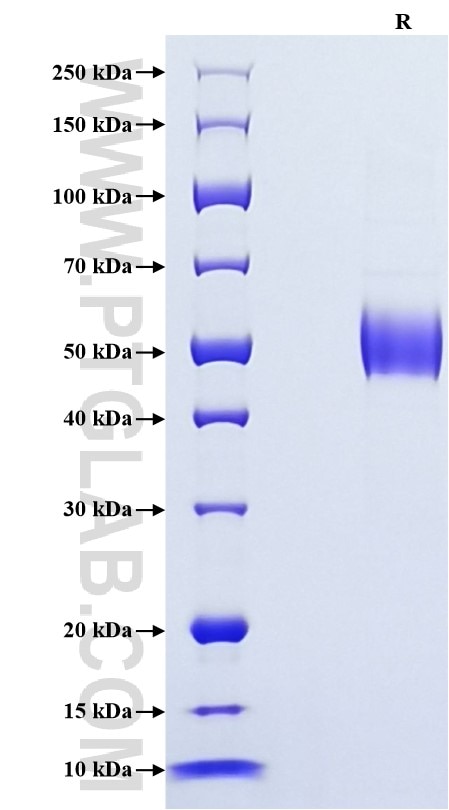Recombinant Mouse CD79B protein (rFc Tag)
Species
Mouse
Purity
>90 %, SDS-PAGE
Tag
rFc Tag
Activity
not tested
Cat no : Eg2113
Validation Data Gallery
Product Information
| Purity | >90 %, SDS-PAGE |
| Endotoxin | <0.1 EU/μg protein, LAL method |
| Activity |
Not tested |
| Expression | HEK293-derived Mouse CD79B protein Val26-Asp158 (Accession# P15530) with a rabbit IgG Fc tag at the C-terminus. |
| GeneID | 15985 |
| Accession | P15530 |
| PredictedSize | 41.4 kDa |
| SDS-PAGE | 47-60 kDa, reducing (R) conditions |
| Formulation | Lyophilized from 0.22 μm filtered solution in PBS, pH 7.4. Normally 5% trehalose and 5% mannitol are added as protectants before lyophilization. |
| Reconstitution | Briefly centrifuge the tube before opening. Reconstitute at 0.1-0.5 mg/mL in sterile water. |
| Storage Conditions |
It is recommended that the protein be aliquoted for optimal storage. Avoid repeated freeze-thaw cycles.
|
| Shipping | The product is shipped at ambient temperature. Upon receipt, store it immediately at the recommended temperature. |
Background
CD79 molecule encompasses two transmembrane proteins, CD79a and CD79b, which form a disulfide-linked heterodimer and are members of the immunoglobulin (Ig) gene superfamily. CD79b molecule (also known as B29, IGB, AGM6, and Igbeta) is expressed almost exclusively on B cells and B-cell neoplasms, influencing antigen internalization and increasing antigen presentation efficiency. CD79b mutation could be a key biomarker for DLBCL disease progression.
References:
1. C J van Noesel, et al. (1991). J Immunol. Jun 1;146(11):3881-8. 2. C J Van Noesel, et al. (1992). J Exp Med. Jun 1;175(6):1511-9. 3. J Hombach, et al. (1990). Nature. Feb 22;343(6260):760-2. 4. C Bonnerot, et al. (1995). Immunity. Sep;3(3):335-47. 5. Peng-Peng Xu, et al. (2022). Clin Lymphoma Myeloma Leuk. Dec;22(12):e1051-e1058.e1.

